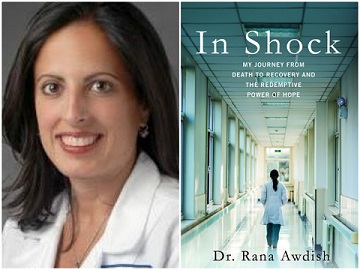The physician/writer's own brush with death opened her eyes to patients' plights.

Rana Awdish, M.D., discovered the power and importance of compassion and communication while lying in a bed in her own hospital. Her book, In Shock: My Journey from Death to Recovery and the Redemptive Power of Hope, chronicles Awdish’s ordeal of almost bleeding to death following a pregnancy loss. Her experiences revealed problems with the healthcare system and the people providing the care itself.
Did being a physician prepare you for the medical crisis you endured?
I don’t believe being a physician prepared me to go through this. In some ways, it made everything more difficult. Physicians, especially, tend to believe they are “other” and that most of what they see each day will not affect them. My transformation from physician to patient was difficult — so difficult that I completely lost any sense of identity. But I also gained a different lens, a patient lens. When I had the patient lens, I saw things entirely differently.
Physician education treats patients’ questions as a “request for data”; once the physician gets the data, the answer will be there. Why is this not an effective way of looking at care?
We can listen to our patients on several different channels at the same time. Questions are not only a request for data. Questions may also be a plea for connection in some way. Although someone may ask about antibiotics, the real question may be [about whether] their loved one will survive. The questions do need to be decoded. We do our patients a much greater service if we provide more than just the cognitive [information].
Are the priorities of the healthcare system clear?
Patients’ vision of a successful healthcare system is much more unified than we give credit. The corporate enterprise of medicine has made it much more complicated. Most patients are clear that they want a caring and compassionate provider who knows them as a whole person and understands them in the context of their life story. A provider who can work with them to heal them and keep them well. Though I treat a very specific disease, pulmonary hypertension, patients don’t just come to me for treatment of their heart and lungs. They come to me as whole people. I can’t be effective if I don’t see them in the whole context of who they are — including mental health, socioeconomic realities, [and] health-literacy issues. I have to see them in the context of who they are.
Do we teach physicians to communicate in the right way?
We teach medical students to communicate clinically in a way that is efficient if all we are concerned with is pathology. We act as if we are intersecting with the patient’s life in that one time only and as if the only relevant information is clinical. People have a whole life story that is broader. We can’t distill patients down to their pathology. We aren’t intersecting with patients only in the moment of illness. Communicating in the way we do doesn’t allow us to see patients as a whole.
Would doctors be more compassionate if they had to assume the patient role at some time during their training?
There is a need for more vulnerability by physicians and humility in medicine. There are issues with the authority gradient while students are still in training, and assuming the patient role may do nothing but make the vulnerable more vulnerable. The timing of when students acquire the “patient lens” may be when trainees have a bit more power than when they are still bound by the teacher-student relationship. You have to know what you are missing as an adult learner to pull it towards you. Students may be too early in their training to benefit from this approach.
How should we instill more resilience in providers?
There is no single answer. What worked for me might not fill the bucket of another provider. Just as we can’t presuppose what’s right for our patients, we can’t presuppose what is right for our providers. There is no single solution. But what I do know is that there can be no individual resilience without organizational resilience. Alignment of organizational values with the work, having authentic leaders, these things promote organizational resilience. Individual resilience in a broken system is no solution at all.
Where does suffering fit in this paradigm?
We are very uncomfortable with suffering. As physicians, we want to effect change, and suffering can at times feel insurmountable to us. But learning to value our presence even when we cannot heal, learning that therapeutic presence can be healing, these things can move us closer to our purpose.
Has the book been accepted within the medical world?
Yes, far more than I could have ever anticipated. It has been integrated into the curriculum of over 50 medical schools. It is being taught in ethics curriculums in Ireland, the U.K., and Australia. It has been translated into eight languages. When I was writing it, I wasn’t sure who the audience would be, but it’s definitely found a home.
Where do you want to see the book used in the future?
If patients and physicians come together to change the system, we could be unstoppable. Policy does drive change. Physicians and patients must realize that we are on the same side and that we can and must change the system.
Tyler Cymet, DO, is the chief of Clinical Education at the American Association of Colleges of Osteopathic Medicine and is a clinical associate professor at the New York Institute of Technology, College of Osteopathic Medicine and sees patients in the emergency department at the University of Maryland Capital Region. He is also the author of Health Info to Go: General Medicine and Addictionary: Guide to Drug User Terminology.
_80_60.jpg)